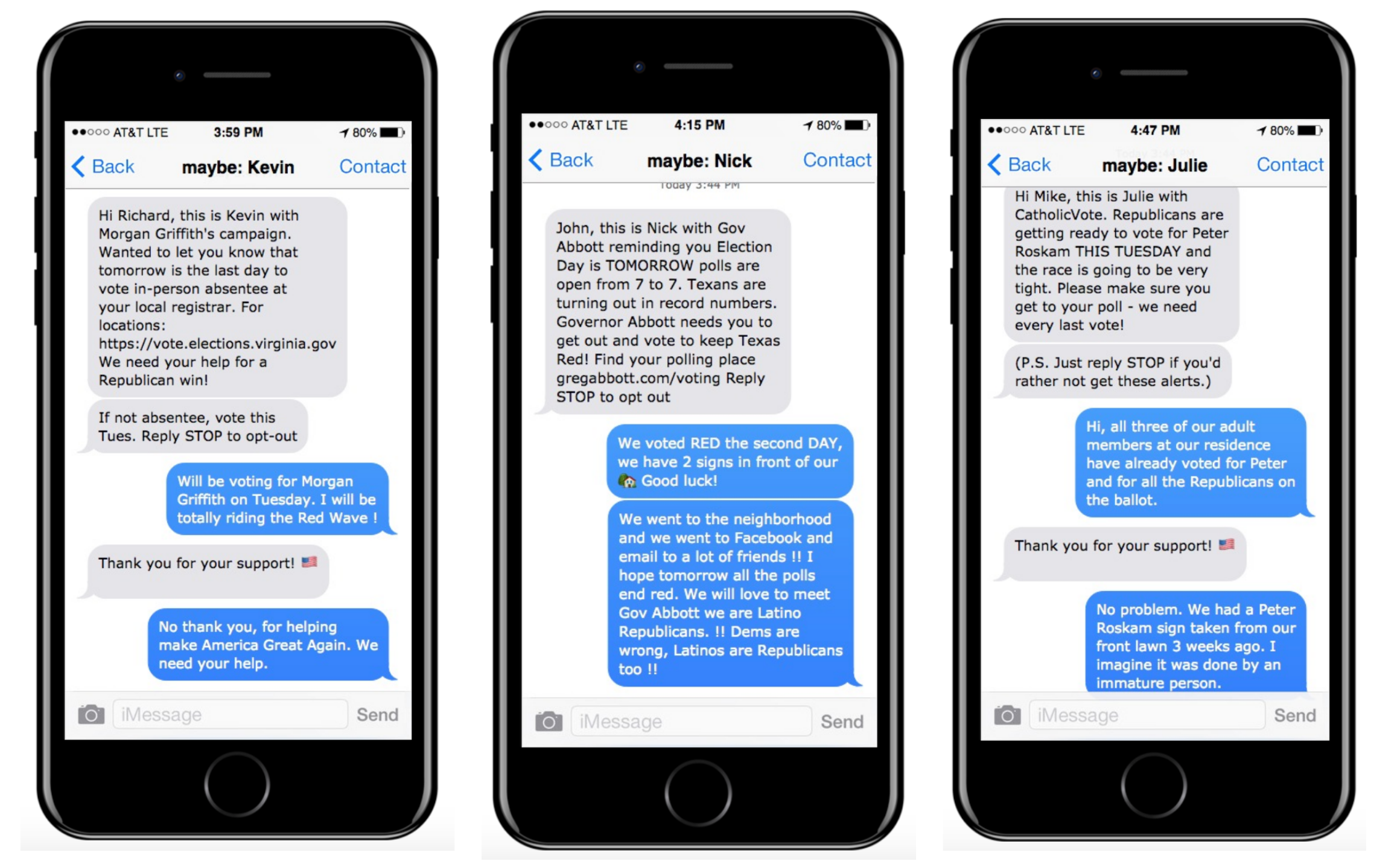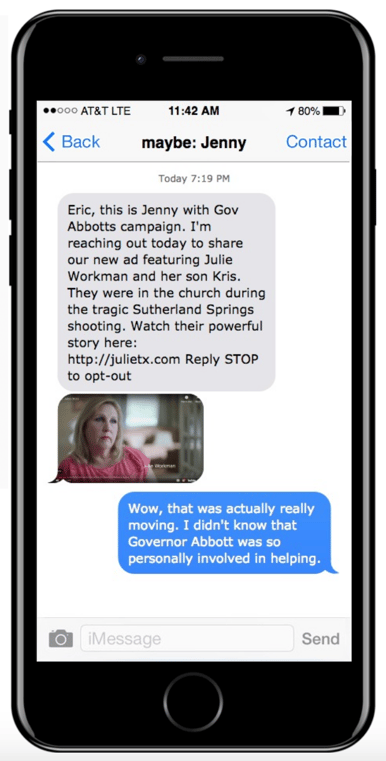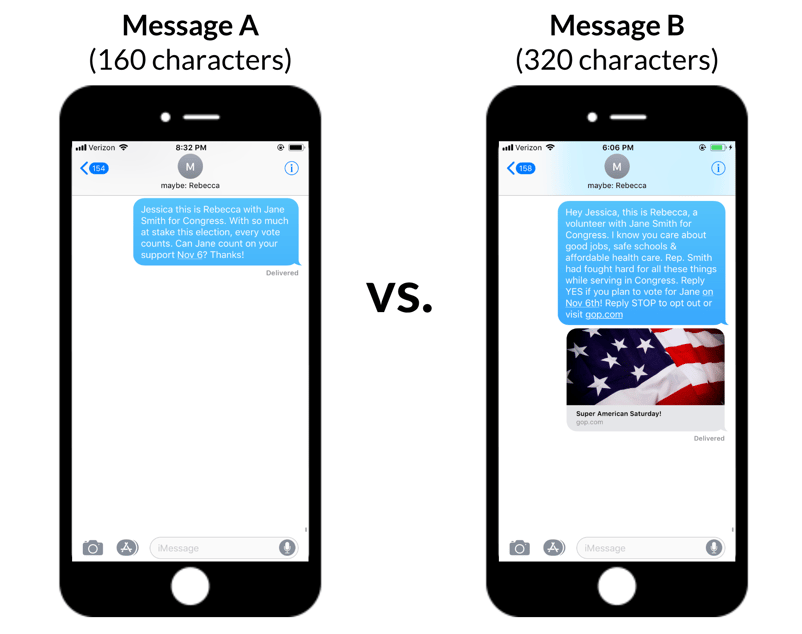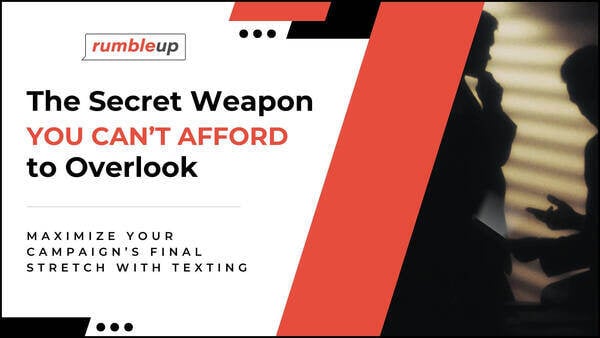Why Most P2P Texting Companies Crashed 72 Hours Before the Midterms

Though some peer-to-peer companies don’t want to talk about it, the final 72 hour texting sprint before the Midterm elections was interrupted spectacularly.
Here’s an inside explainer from one of the companies that didn’t #FailWhale.
2018 was the year of the political text message.
A record number of peer-to-peer texts were sent by Democrat and Republican volunteers leading up to this year’s midterm elections.
You probably know what we’re talking about and received some text messages that looked similar to the ones below.

If you were one of the thousands of volunteers sending peer-to-peer texts in the final days before the midterm elections, you may recall a sudden service outage that left the majority of P2P companies with drastically reduced service.
The crash came about because there was a dramatic spike in the amount of peer-to-peer texts being sent persuading or reminding people to vote by hundreds of clients. From several million texts a day, up to as many as a hundred million texts a day during the final three days!
This massive spike in traffic overwhelmed the provider, causing a near total collapse of the Multimedia Messaging Service (MMS) network, and a severe reduction in options for sending regular (Short Message Service) SMS text messages as well.
In practice this meant all the P2P companies who relied on this provider could send hardly any MMS messages (texts with a multimedia attachment like an image, GIF or video) and had to cut down the allowable character count their clients could use in standard SMS text messages — and even worse, no more emojis!
Past is Prologue
Our RumbleUp team knew months before this crash that the massive spike in anticipated traffic had the potential to test the capacity limits of the downstream delivery provider we (and most other P2P companies) depend on to deliver the messages our clients send one-by-one.
A month prior to the election, we experienced firsthand what it is like to have your downstream provider crash.
One day, while in the process of delivering over 440,000 MMS messages for a client who was sending around a video, our outbound capacity unexpectedly got cut by our service provider.

It became clear that we would not be able to get all of the messages out in time if we continued to deliver through them.
With only a few hours left before the cut-off time to deliver messages (our client didn’t want people receiving texts later than 9pm local time), our developers wasted no time diving in and searching for a solution.
At this point, we already had the ability to deliver messages via multiple providers. From the beginning, our developers never wanted to have a single point of failure in our system.
The preferred method however, of the most popular service providers, requires companies like ours to choose one and only one provider. The benefit is that the provider in turn handles many complicated technical tasks for you (saving your development team time and hassle). But because you’re basically locked-in to using them, if they go down, you go down with them.
Many other P2P companies took this easier road, but our developers made sure our system could support multiple providers and instead created a provider-agnostic system.
More work for us, but more flexibility in return.
This allowed us to find a fix that enabled us to switch providers mid-send and finish delivering the texts with a different provider than the one we started with.
Best of all, our clients’ agents (the term we use for volunteers sending the texts) barely noticed a hiccup!
After coming out of this fire drill unscathed and with a new set of tools to use for situations like this, when we received the notice from our provider days before the general election, switching to another provider was as simple as flipping a switch.
So What Happened to Everyone Else?
When a P2P text is sent, it is delivered the same way any other text message is routed. It goes from the sender to the provider, then from the provider to the individual phone carriers (AT&T, Verizon, etc.), and then finally from the phone carrier to the recipient.
There are only a small handful of providers that support the entire phone carrier network.
Three days before the midterms, the most popular provider used by P2P companies crashed due to the massive amount of texts being sent reminding people to vote.
The provider simply could not pass on the amount of messages being delivered to it.
This caused a slowdown for all P2P companies who relied on this provider to deliver their messages. They could barely send any MMS messages, and their bandwidth to send SMS messages was significantly hampered as well.
Throughout all of this, here at RumbleUp we remained fully operational with zero downtime or reduced service capacity for either MMS or SMS messages.
All P2P companies who relied on the crashed provider dropped any client that had to send 10,000 MMS messages or more down to 72 messages per hour and the provider asked P2P companies to have their clients reduce their SMS messages down to 160 characters (all this time RumbleUp continued to deliver at optimal speed and double the length — 320 characters).

Imagine spending weeks or months crafting and optimizing your 320 character get-out-the-vote message and then being told three days before the election that you need to cut it in half so it could go out at all. Or spending thousands of dollars or more creating mobile-optimized video content to use as a persuasion or motivation piece to attach to your text message and having to scrap it completely.
This happened to dozens of campaigns and groups that went with other peer-to-peer texting companies.
Meanwhile, the average volunteer on our RumbleUp system could send 2,500 messages per hour and most campaigns employ dozens of volunteers. Our clients could also keep their messages up to 320 characters without having to worry about congesting the network, and include a multimedia attachment.
The provider eventually sent out a notification when things were back to normal, but it was over 25 hours of significant downtime and even after the network recovered they still advised people not to send MMS messages.
If people relying on the crashed provider had been constantly sending during that time, they would have only been able to deliver about 1,500 MMS messages total — a minuscule amount for any campaign larger than a small local race.
In the same timeframe, our clients could deliver hundreds of thousands of MMS messages without breaking a sweat.
What Made the Difference?
Unlike other P2P companies, our system is built to be provider agnostic, so we are never reliant on just one provider to deliver our messages. This proved to be a wise choice. To our knowledge, we were one of the few (if not the only) P2P company that was able to continue delivering our messages without a hitch, throughout the entire election cycle.
The final 72 hours before the election is the most crucial time to be having conversations with potential voters and is certainly not the time you want your system to break down. We are proud to have been able to continue sending texts during this outage and plan to continue offering the highest level of dependability and reliability to our clients.
There are dozens of ways to continue engaging your supporters via text and reaching out to new ones:
Fundraising, Constituent Contact, Event Attendance, Polling/Surveys, Lobbying, & so much more!
Our team is ready to help you create the perfect P2P plan to complement your already existing outreach programs. Send us an email at sales@rumbleup.com and let’s talk about how to amplify your reach!
![Peerly vs CallHub: P2P Texting Platform Comparison [July 2025]](https://rumbleup.com/hubfs/Peerly%20vs%20CallHub%20vs%20RumbleUp.png)

